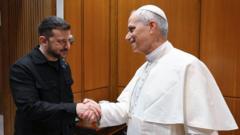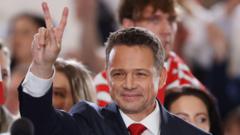The first papal conclave in over ten years has commenced in Vatican City, as 133 cardinals convene to elect a new leader for 1.4 billion Roman Catholics. Following a Mass at St. Peter's Basilica, the cardinals entered the Sistine Chapel, swearing an oath of secrecy amidst a critical time for the Church that grapples with internal divisions, financial concerns, and the fallout from past abuse scandals.
Cardinals Conclave Commences to Choose New Pope Amid Church Divisions

Cardinals Conclave Commences to Choose New Pope Amid Church Divisions
The historic conclave has begun, with 133 cardinals gathering in the Sistine Chapel to select a successor to Pope Francis, facing a divided Church and pressing issues.
---
Gathering under the iconic frescoes of Michelangelo's Sistine Chapel, 133 cardinals have begun a pivotal conclave to elect the next pope following the death of Pope Francis. This significant event represents the first papal conclave in over a decade. The cardinals, clad in red, processed into the chapel where they will be secluded and barred from external communication as they deliberate on the future direction of the church.
The doors of the Sistine Chapel closed behind them, marking the separation from the outside world, where an eager public and faithful await news. Before entering conclave, the cardinals participated in a solemn Mass at St. Peter’s Basilica, invoking divine guidance for their decision-making.
This conclave occurs at a time of considerable uncertainty for the Catholic Church. Many of the cardinals were appointed by Pope Francis, leading some observers to speculate on the potential for a more fragmented voting process due to differing priorities and political dynamics among the cardinals. The church is presently confronting significant issues related to financing, the handling of historical sexual abuse scandals, and ideological divides, with progressives advocating for reform and conservatives pushing to maintain traditional values.
As the cardinals prepared for the initial round of voting, the immediate goal is to achieve a two-thirds majority to elect a new pope. However, an initial vote is unlikely to yield a decision. If no one is elected, further rounds of voting will follow each day until a consensus emerges, continuing the tradition that has defined papal elections for centuries.
The Sistine Chapel, a UNESCO World Heritage site, provides a dramatic backdrop for this sacred political process, filled with rich symbolism and historical resonance. The cardinals' experience in this artistic and religious environment is expected to weigh heavily on their deliberations. All eyes are now fixed on the chapel as the world waits for smoke signals – white for a new pope, black for more voting – to announce the outcome of this historic conclave.
Gathering under the iconic frescoes of Michelangelo's Sistine Chapel, 133 cardinals have begun a pivotal conclave to elect the next pope following the death of Pope Francis. This significant event represents the first papal conclave in over a decade. The cardinals, clad in red, processed into the chapel where they will be secluded and barred from external communication as they deliberate on the future direction of the church.
The doors of the Sistine Chapel closed behind them, marking the separation from the outside world, where an eager public and faithful await news. Before entering conclave, the cardinals participated in a solemn Mass at St. Peter’s Basilica, invoking divine guidance for their decision-making.
This conclave occurs at a time of considerable uncertainty for the Catholic Church. Many of the cardinals were appointed by Pope Francis, leading some observers to speculate on the potential for a more fragmented voting process due to differing priorities and political dynamics among the cardinals. The church is presently confronting significant issues related to financing, the handling of historical sexual abuse scandals, and ideological divides, with progressives advocating for reform and conservatives pushing to maintain traditional values.
As the cardinals prepared for the initial round of voting, the immediate goal is to achieve a two-thirds majority to elect a new pope. However, an initial vote is unlikely to yield a decision. If no one is elected, further rounds of voting will follow each day until a consensus emerges, continuing the tradition that has defined papal elections for centuries.
The Sistine Chapel, a UNESCO World Heritage site, provides a dramatic backdrop for this sacred political process, filled with rich symbolism and historical resonance. The cardinals' experience in this artistic and religious environment is expected to weigh heavily on their deliberations. All eyes are now fixed on the chapel as the world waits for smoke signals – white for a new pope, black for more voting – to announce the outcome of this historic conclave.




















